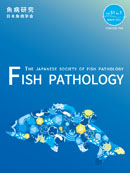
- |<
- <
- 1
- >
- >|
-
Mass Mortality Caused by Pseudomonas anguilliseptica in the Pond-cultured Ayu Plecoglossus altivelisYoshiko Shimahara, Yasuhiko Kawato, Ikunari Kiryu, Toyohiro Nishioka, ...Article type: Short Communication
2018Volume 53Issue 3 Pages 101-104
Published: September 15, 2018
Released on J-STAGE: October 19, 2018
JOURNAL FREE ACCESSPseudomonas anguilliseptica infections have not been reported in cultured ayu Plecoglossus altivelis in Japan since a few occurrences in the 1980s. In the spring of 2013, however, mass mortality was encountered at an ayu rearing facility in Akita Prefecture, Japan, and the causative agent was identified as P. anguilliseptica. In this study, biochemical characterizations and 16S rRNA gene sequences of the isolates from the present event were shown to be identical to previously reported isolates of P. anguilliseptica from ayu. LD50 of the present isolate against ayu in the infection test was 1.7 × 103 cfu/fish.
View full abstractDownload PDF (993K) -
Jumpei Arakawa, Tohru MekataArticle type: Short Communication
2018Volume 53Issue 3 Pages 105-109
Published: September 15, 2018
Released on J-STAGE: October 19, 2018
JOURNAL FREE ACCESSIn 2017, one individual of goldfish Carassius auratus which had tumor-like massive lesions in the skin was found in a goldfish wholesale market in Aichi Prefecture, Japan. The lesions were 2–4 mm in diameter and hemorrhage was observed in some of them. Microscopic observation revealed numerous myxospores with a single polar capsule. The spores were 17.1 ± 1.0 μm (mean ± SD) long, and 6.1 ± 0.7 μm wide. The partial sequence of 18S rRNA gene was 100% identical to that of Thelohanellus testudineus. This is the first report of T. testudineus in goldfish.
View full abstractDownload PDF (1059K) -
Alkhateib Y. Gaafar, Hirofumi Yamashita, Indah Istiqomah, Yasuhiko Kaw ...Article type: Short Communication
2018Volume 53Issue 3 Pages 110-113
Published: September 15, 2018
Released on J-STAGE: October 19, 2018
JOURNAL FREE ACCESSTo develop an oral vaccination method for viral nervous necrosis (VNN) caused by piscine nodavirus (betanodavirus), sevenband grouper Epinephelus septemfasciatus was immunized with inactivated redspotted grouper nervous necrosis virus (RGNNV) vaccine. Seven-day consecutive oral administration of the RGNNV vaccine via feed failed to induce protection in fish against the virus challenge at 21 days post-immunization. However, anal intubation of the vaccine conferred protective immunity on fish, although virus neutralizing antibodies could not be detected. Similar protective immunity was also confirmed by oral administration of vaccine via feed supplemented with capsaicin, suggesting that capsaicin modulated the intestinal mucosal barrier to induce immune response.
View full abstractDownload PDF (963K)
- |<
- <
- 1
- >
- >|